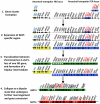Discovery of a modified tetrapolar sexual cycle in Cryptococcus amylolentus and the evolution of MAT in the Cryptococcus species complex
- PMID: 22359516
- PMCID: PMC3280970
- DOI: 10.1371/journal.pgen.1002528
Discovery of a modified tetrapolar sexual cycle in Cryptococcus amylolentus and the evolution of MAT in the Cryptococcus species complex
Abstract
Sexual reproduction in fungi is governed by a specialized genomic region called the mating-type locus (MAT). The human fungal pathogenic and basidiomycetous yeast Cryptococcus neoformans has evolved a bipolar mating system (a, α) in which the MAT locus is unusually large (>100 kb) and encodes >20 genes including homeodomain (HD) and pheromone/receptor (P/R) genes. To understand how this unique bipolar mating system evolved, we investigated MAT in the closely related species Tsuchiyaea wingfieldii and Cryptococcus amylolentus and discovered two physically unlinked loci encoding the HD and P/R genes. Interestingly, the HD (B) locus sex-specific region is restricted (∼2 kb) and encodes two linked and divergently oriented homeodomain genes in contrast to the solo HD genes (SXI1α, SXI2a) of C. neoformans and Cryptococcus gattii. The P/R (A) locus contains the pheromone and pheromone receptor genes but has expanded considerably compared to other outgroup species (Cryptococcus heveanensis) and is linked to many of the genes also found in the MAT locus of the pathogenic Cryptococcus species. Our discovery of a heterothallic sexual cycle for C. amylolentus allowed us to establish the biological roles of the sex-determining regions. Matings between two strains of opposite mating-types (A1B1×A2B2) produced dikaryotic hyphae with fused clamp connections, basidia, and basidiospores. Genotyping progeny using markers linked and unlinked to MAT revealed that meiosis and uniparental mitochondrial inheritance occur during the sexual cycle of C. amylolentus. The sexual cycle is tetrapolar and produces fertile progeny of four mating-types (A1B1, A1B2, A2B1, and A2B2), but a high proportion of progeny are infertile, and fertility is biased towards one parental mating-type (A1B1). Our studies reveal insights into the plasticity and transitions in both mechanisms of sex determination (bipolar versus tetrapolar) and sexual reproduction (outcrossing versus inbreeding) with implications for similar evolutionary transitions and processes in fungi, plants, and animals.
Conflict of interest statement
The authors have declared that no competing interests exist.
Figures









Similar articles
-
The mating type locus (MAT) and sexual reproduction of Cryptococcus heveanensis: insights into the evolution of sex and sex-determining chromosomal regions in fungi.PLoS Genet. 2010 May 20;6(5):e1000961. doi: 10.1371/journal.pgen.1000961. PLoS Genet. 2010. PMID: 20502678 Free PMC article.
-
Transitions in sexuality: recapitulation of an ancestral tri- and tetrapolar mating system in Cryptococcus neoformans.Eukaryot Cell. 2008 Oct;7(10):1847-55. doi: 10.1128/EC.00271-08. Epub 2008 Aug 22. Eukaryot Cell. 2008. PMID: 18723606 Free PMC article.
-
The Pheromone and Pheromone Receptor Mating-Type Locus Is Involved in Controlling Uniparental Mitochondrial Inheritance in Cryptococcus.Genetics. 2020 Mar;214(3):703-717. doi: 10.1534/genetics.119.302824. Epub 2019 Dec 30. Genetics. 2020. PMID: 31888949 Free PMC article.
-
The Evolution of Sexual Reproduction and the Mating-Type Locus: Links to Pathogenesis of Cryptococcus Human Pathogenic Fungi.Annu Rev Genet. 2019 Dec 3;53:417-444. doi: 10.1146/annurev-genet-120116-024755. Epub 2019 Sep 19. Annu Rev Genet. 2019. PMID: 31537103 Free PMC article. Review.
-
An Overview of the Function and Maintenance of Sexual Reproduction in Dikaryotic Fungi.Front Microbiol. 2018 Mar 21;9:503. doi: 10.3389/fmicb.2018.00503. eCollection 2018. Front Microbiol. 2018. PMID: 29619017 Free PMC article. Review.
Cited by
-
Multigene assessment of the species boundaries and sexual status of the basidiomycetous yeasts Cryptococcus flavescens and C. terrestris (Tremellales).PLoS One. 2015 Mar 26;10(3):e0120400. doi: 10.1371/journal.pone.0120400. eCollection 2015. PLoS One. 2015. PMID: 25811603 Free PMC article.
-
Convergent evolution of linked mating-type loci in basidiomycete fungi.PLoS Genet. 2019 Sep 6;15(9):e1008365. doi: 10.1371/journal.pgen.1008365. eCollection 2019 Sep. PLoS Genet. 2019. PMID: 31490920 Free PMC article.
-
Mating type (MAT) locus and possible sexuality of the opportunistic pathogen Exophiala dermatitidis.Fungal Genet Biol. 2019 Mar;124:29-38. doi: 10.1016/j.fgb.2018.12.011. Epub 2019 Jan 3. Fungal Genet Biol. 2019. PMID: 30611834 Free PMC article.
-
Loss of centromere function drives karyotype evolution in closely related Malassezia species.Elife. 2020 Jan 20;9:e53944. doi: 10.7554/eLife.53944. Elife. 2020. PMID: 31958060 Free PMC article.
-
A Large-Scale Functional Analysis of Putative Target Genes of Mating-Type Loci Provides Insight into the Regulation of Sexual Development of the Cereal Pathogen Fusarium graminearum.PLoS Genet. 2015 Sep 3;11(9):e1005486. doi: 10.1371/journal.pgen.1005486. eCollection 2015 Sep. PLoS Genet. 2015. PMID: 26334536 Free PMC article.
References
-
- Michod RE, Bernstein H, Nedelcu AM. Adaptive value of sex in microbial pathogens. Infection, Genetics and Evolution. 2008;8:267–285. - PubMed
-
- Heitman J. Sexual reproduction and the evolution of microbial pathogens. Current Biology. 2006;16:R711–725. - PubMed
-
- Fraser JA, Hsueh Y-P, Findley K, Heitman J. Evolution of the mating-type locus - the basidiomycetes. In: Heitman JWK J, Taylor JW, Casselton LA, editors. Sex in Fungi: molecular determination and evolutionary implications. Washington, DC: ASM Press; 2007. pp. 19–34.
-
- Lin X, Hull CM, Heitman J. Sexual reproduction between partners of the same mating type in Cryptococcus neoformans. Nature. 2005;434:1017–1021. - PubMed
Publication types
MeSH terms
Substances
Grants and funding
LinkOut - more resources
Full Text Sources
Research Materials

